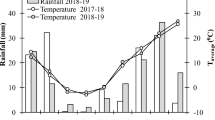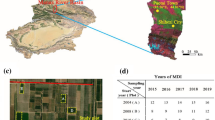Abstract
Soil salinity and associated problems are the major challenge for the arid region of Northwest China. Strategies to cope with salinity, including a better understanding of the impacts of soil salinity on the crop coefficient (Kc), are essential for precision irrigation in arid regions. In this study, two years of non-weighing lysimeter (NWL) experiments were conducted to investigate the Kc of cotton (Gossypium hirsutum L.) under different degrees of soil salinization. The stress coefficient (Ks) model was modified and validated based on the NWL and field experiments. Three irrigation water qualities (GW, groundwater, 1.27 g l−1; BW, brackish water, 3.03 g l−1; SW, saline water, 4.90 g l−1) were applied to mulched-drip irrigated cotton. Both NWL and field experiments revealed that BW and SW irrigation increased the soil salt content which reached the moderately saline soil level. Adjusted for local weather, the Kc-Local of cotton for the initial, middle and end seasons was 0.29, 1.10 and 0.52 under slightly saline soil (GW irrigation) and 0.24, 0.98 and 0.46 under moderately saline soil (BW and SW irrigation). In addition, the linear negative correlation relationships of soil ECe with yield response factor (Ky) and slope b (reduction in yield per increase in ECe beyond the ECe threshold) were developed. Furthermore, the Ks model was modified under salt stress conditions, which provided an acceptable Ks estimation under field conditions. These findings could be helpful for efficient water management in cotton cropping systems under mulched drip irrigation in arid regions.













Similar content being viewed by others
Availability of data and materials
All data and materials that support the fndings of this study are available from the corresponding author upon reasonable request.
Abbreviations
- NWL:
-
Non-weighing lysimeter
- K c :
-
Crop coefficient
- K c–Local :
-
Actual crop coefficient (the ratio of ETa and the ETo)
- K c-adj :
-
Kc under salt stress
- K c-ini :
-
Kc during the initial-season
- K c-mid :
-
Kc during the middle-season
- K c-end :
-
Kc at end of the late-season
- K s :
-
Stress coefficient
- K y :
-
Yield response factor
- b :
-
Reduction in yield per increase in ECe beyond the ECe threshold (%/(dS m−1))
- Bs a :
-
Actual biomass (kg ha−1)
- Bs m :
-
Maximum biomass (kg ha−1)
- EC 1 :5 :
-
Electrical conductivity of 1:5 soil to water extract from the root zone (dS m−1)
- EC e :
-
Electrical conductivity of the saturation extract from the root zone (dS m−1)
- EC e threshold :
-
Electrical conductivity of the saturation extract of the soil above which yield begins to decrease (dS m−1)
- ET o :
-
Reference crop evapotranspiration (mm)
- ET c :
-
Crop water requirement (mm)
- ET a :
-
Crop actual evapotranspiration (mm)
- I :
-
Irrigation amount (mm)
- P e :
-
Effective rainfall (mm)
- D p :
-
Deep percolation (mm)
- R off :
-
Runoff (mm)
- ΔS :
-
Variation in soil water storage (mm)
- GDD:
-
Growing degree days (℃)
- T max :
-
The daily maximum temperature (℃)
- T min :
-
The daily minimum temperature (℃)
- T basal :
-
The basal temperature (℃)
- GW:
-
Groundwater (1.27 g l−1)
- BW:
-
Brackish water (3.03 g l−1)
- SW:
-
Saline water (4.90 g l−1)
- R2 :
-
Determination coefficient
- RMSE:
-
Root mean square error
- NSE:
-
Nash–Sutcliffe efficiency coefficient
References
Allen RG, Pereira LS, Raes D, Smith M (1998) Crop evapotranspiration-Guidelines for computing crop water requirements-FAO Irrigation and drainage paper 56, vol 300, no 9. FAO, Rome, Italy, p D05109
Allen RG, Pereira LS, Howell TA, Jensen ME (2011) Evapotranspiration information reporting: I. factors governing measurement accuracy. Agric Water Manag 98(6):899–920. https://doi.org/10.1016/j.agwat.2010.12.015
Ben-Gal A, Karlberg L, Janson PK, Shani U (2003) Temporal robustness of linear relationships between production and transpiration. Plant Soil 251:211–218. https://doi.org/10.1023/A:1023004024653
Ben-Gal A, Ityel E, Dudley L, Cohen S, Yermiyahu U, Presnov E, Zigmond L, Shani U (2008) Effect of irrigation water salinity on transpiration and on leaching requirements: a case study for bell peppers. Agric Water Manag 95:587–597. https://doi.org/10.1016/j.agwat.2007.12.008
Che Z, Wang J, Li JS (2021) Effects of water quality, irrigation amount and nitrogen applied on soil salinity and cotton production under mulched drip irrigation in arid Northwest China. Agric Water Manag. https://doi.org/10.1016/j.agwat.2021.106738
Department of Agriculture and Rural Affairs of Xinjiang (1996) Soil of Xinjiang. Science Press, Beijing, China, p 440
Dudley LM, Ben-Gal A, Lazarovitch N (2008) Drainage water reuse: biological, physical, and technological considerations for system management. J Environ Qual 37:S25–S35. https://doi.org/10.2134/jeq2007.0314
Evett SR, Schwartz RC, Howell TA, Baumhardt RL, Copeland KS (2012) Can weighing lysimeter ET represent surrounding field ET well enough to test flux station measurements of daily and subdaily ET? Adv Water Resour 50:79–90. https://doi.org/10.1016/j.advwatres.2012.07.023
Farahani HJ, Oweis TY, Izzi G (2008) Crop coefficient for drip-irrigated cotton in a mediterranean environment. Irrig Sci 26(5):375–383. https://doi.org/10.1007/s00271-007-0101-0
Han SM, Yang YH, Li HL, Yang YM, Wang JS, Cao JS (2019) Determination of crop water use and coefficient in drip-irrigated cotton fields in arid regions. Field Crop Res 236:85–95. https://doi.org/10.1016/j.fcr.2019.03.008
Hassanli M, Ebrahimian H (2016) Cyclic use of saline and nonsaline water to increase water use efficiency and soil sustainability on drip irrigated maize in a semiarid mregion. Span J Agric Res 14(4):e1204. https://doi.org/10.5424/sjar/2016144-9238
Hassanli M, Ebrahimian H, Mohammadi E, Rahimi A, Shokouhi A (2016) Simulating maize yields when irrigating with saline water using the Aqua crop, SALTMED, and SWAP models. Agric Water Manag 176:91–99. https://doi.org/10.1016/j.agwat.2016.05.003
Hong MH, Zeng WZ, Ma T, Lei GQ, Zha YY, Fang YH, Wu JW, Huang JS (2017) Determination of growth stage-specific crop coefficients (Kc) of sunflowers (Helianthus annuus L.) under salt stress. Water 9(3):215. https://doi.org/10.3390/w9030215
Hopmans JW, Qureshi AS, Kisekka I, Munns R, Grattan SR, Rengasamy P, Ben-Gal A, Assouline S, Javaux M, Minhas PS, Raats PAC, Skaggs TH, Wang G, Jong De, van Lier Q, Jiao H, Lavado RS, Lazarovitch N, Li B, Taleisnik E (2021) Critical knowledge gaps and research priorities in global soil salinity. Adv Agron 169:1–191. https://doi.org/10.1016/bs.agron.2021.03.001
Hou XH, Fan JL, Zhang FC, Hu WH, Yan FL, Xiao C, Li YP, Cheng HL (2022) Determining water use and crop coefficients of drip-irrigated cotton in south Xinjiang of China under various irrigation amounts. Ind Crop Prod. https://doi.org/10.1016/j.indcrop.2021.114376
Ihuoma SO, Madramootoo CA (2017) Recent advances in crop water stress detection. Comput Electron Agric 141:267–275. https://doi.org/10.1016/j.compag.2017.07.026
Libardi LGP, Faria RTD, Dalri AB (2019) Evapotranspiration and crop coefficient (Kc) of resprouted sugarcane plantlets for greenhouse irrigation management. Agric Water Manag 212:306–316. https://doi.org/10.1016/j.agwat.2018.09.003
Lovelli S, Perniola M, Ferrara A, Di Tommaso T (2007) Yield response factor to water (Ky) and water use efficiency of Carthamus tinctorius L. and Solanum melongena L. Agric Water Manag 92:73–80. https://doi.org/10.1016/j.agwat.2007.05.005
Mapel CL, Sammis TW, Lansford RR (1985) Estimating crop water production functions based on transpiration and crop growth curves through modeling. Partial Completion Report Project No. WRRI 1–3–45669, New Mexico Water Resources Institute, pp 38
Minhas PS, Ramos TB, Ben-Gal A, Pereira LS (2020) Coping with salinity in irrigated agriculture: crop evapotranspiration and water management issues. Agric Water Manag. https://doi.org/10.1016/j.agwat.2019.105832
Pereira LS, Paredes P, Jovanovic N (2020) Soil water balance models for determining crop water and irrigation requirements and irrigation scheduling focusing on the FAO-56 method and the dual Kc approach. Agric Water Manag. https://doi.org/10.1016/j.agwat.2020.106357
Pereira LS, Paredes P, Hunsaker DJ, López-Urrea R, Shad ZM (2021) Standard single and basal crop coefficients for field crops. updates and advances to the FAO-56 crop water requirements method. Agric Water Manag. https://doi.org/10.1016/j.agwat.2020.106466
Ren FT, Yang G, Li WJ, He XL, Gao YL, Tian LJ, Li FD, Wang ZL, Liu SH (2021) Yield-compatible salinity level for growing cotton (Gossypium hirsutum L.) under mulched drip irrigation using saline water. Agric Water Manag. https://doi.org/10.1016/j.agwat.2021.106859
Saeidi R, Etedali HR, Sotoodehnia A, Kaviani A, Nazari B (2021) Salinity and fertility stresses modify Ks and readily available water coefficients in maize (case study: Qazvin region). Irrig Sci 39:299–313. https://doi.org/10.1007/s00271-020-00711-1
Sahab S, Suhani I, Srivastava V, Chauhan PS, Singh RP, Prasad V (2021) Potential risk assessment of soil salinity to agroecosystem sustainability: current status and management strategies. Sci Total Environ. https://doi.org/10.1016/j.scitotenv.2020.144164
Shani U, Dudley LM (2001) Field studies of crop response to water and salt stress. Soil Sci Soc Am J 65:1522–1528. https://doi.org/10.2136/sssaj2001.6551522x
Shani U, Ben-Gal A, Tripler E, Dudley LM (2007) Plant response to the soil environment: an analytical model integrating yield, water, soil type, and salinity. Water Resour Res 43:1–12. https://doi.org/10.1029/2006WR005313
Sharna H, Shukla MK, Bosland PW, Steiner R (2017) Soil moisture sensor calibration, actual evapotranspiration, and crop coefficients for drip irrigated greenhouse chili peppers. Agric Water Manag 179:81–91. https://doi.org/10.1016/j.agwat.2016.07.001
Sonmez S, Buyuktas D, Okturen F, Citak S (2008) Assessment of different soil to water ratios (1:1, 1:2.5, 1:5) in soil salinity studies. Geoderma 144(1–2):361–369. https://doi.org/10.1016/j.geoderma.2007.12.005
Viets F (1962) Fertilizers and the efficient use of water. Adv Agron 14:223–264. https://doi.org/10.1016/S0065-2113(08)60439-3
Wang RS, Kang YH, Wan SQ, Hu W, Liu SP, Liu SH (2011) Salt distribution and the growth of cotton under different drip irrigation regimes in a saline area. Agric Water Manag 100:58–69. https://doi.org/10.1016/j.agwat.2011.08.005
Yamaguchi T, Blumwald E (2005) Developing salt-tolerant crop plants: challenges and opportunities. Trends Plant Sci 10:615–620. https://doi.org/10.1016/j.tplants.2005.10.002
Yang PJ, Hu HC, Tian FQ, Zhang Z, Dai C (2016) Crop coefficient for cotton under plastic mulch and drip irrigation based on eddy covariance observation in an arid area of northwestern China. Agric Water Manag 171:21–30. https://doi.org/10.1016/j.agwat.2016.03.007
Zeng WZ, Xu C, Wu JW, Huang JS, Zhao Q, Wu MS (2014) Impact of salinity and nitrogen on the photosynthetic rate and growth of sunflowers (Helianthus annuus L.). Pedosphere 24(5):635–644. https://doi.org/10.1016/S1002-0160(14)60049-7
Acknowledgements
This project was supported by the National Natural Science Foundation of China (grant nos. 51790531 and 52179055), the Research & Development Support Program of China Institute of Water Resources and Hydropower Research (ID110145B0022021), and the Science and Technology Program of Xinjiang Production and Construction Corps (grant no. 2021DB012, 2022DB020).
Author information
Authors and Affiliations
Contributions
CM: Lysimeter and field experiment, Data analysis and curation, and Original draft. JW: Conceptualization, Methodology, Experimental design, Formal analysis, Data analysis, Resources, Review and editing. JL: Supervision, Funding acquisition, Project administration, Methodology, Review and editing.
Corresponding authors
Ethics declarations
Conflict of interest
On behalf of all authors, the corresponding author states that there is no conflict of interest.
Additional information
Publisher's Note
Springer Nature remains neutral with regard to jurisdictional claims in published maps and institutional affiliations.
Rights and permissions
Springer Nature or its licensor (e.g. a society or other partner) holds exclusive rights to this article under a publishing agreement with the author(s) or other rightsholder(s); author self-archiving of the accepted manuscript version of this article is solely governed by the terms of such publishing agreement and applicable law.
About this article
Cite this article
Ma, C., Wang, J. & Li, J. Evaluation of the effect of soil salinity on the crop coefficient (Kc) for cotton (Gossypium hirsutum L.) under mulched drip irrigation in arid regions. Irrig Sci 41, 235–249 (2023). https://doi.org/10.1007/s00271-022-00842-7
Received:
Accepted:
Published:
Issue Date:
DOI: https://doi.org/10.1007/s00271-022-00842-7




